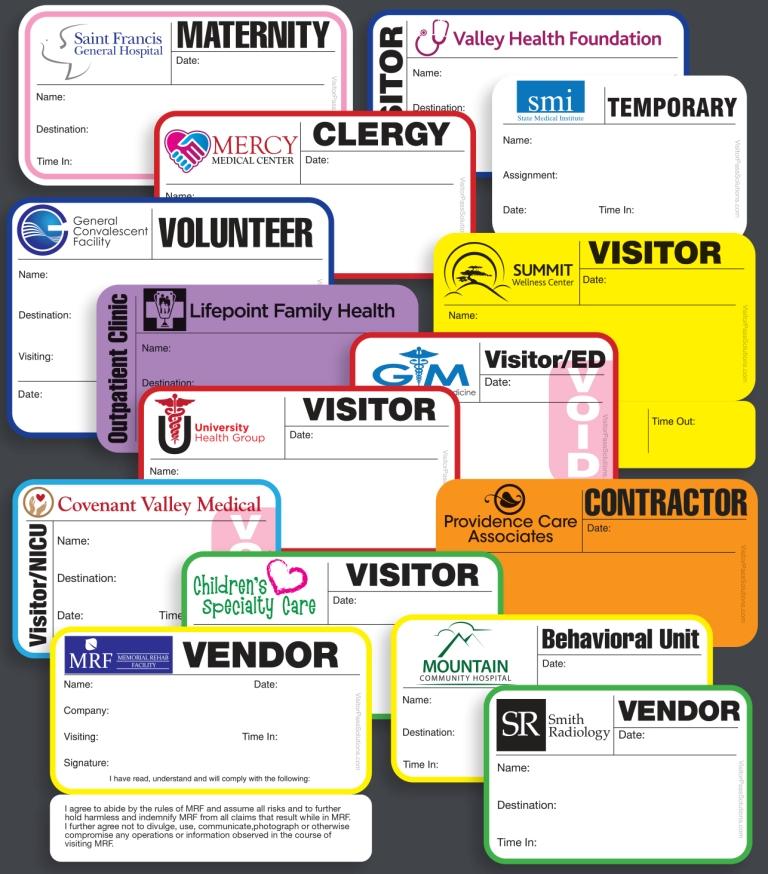Blog
Choosing a visitor management system part 3:
Not all badges are made alike
by Andrew Jones

This is the third of three articles about choosing a visitor management system.
Just as different visitor management systems perform different functions, they also, understandably, comprise different components, depending on your needs and preferences. One of the most important components to consider is the identification badge you use to identify your visitors.
Any time you encounter a stranger at your place of work, you may wonder who he is and what he is doing there — especially if he isn’t wearing an I.D. badge. Some places require visitors to wear a badge, and some don’t. Likewise, some places require employees to wear a badge, while others don’t.
At best, not identifying visitors arouses employees’ curiosity and, at worst, leaves people and property exposed to potential harm. The less an organization relies on identifying its building’s occupants, the more mystery there is about their identity.
A good visitor management system, in conjunction with the policies it supports, should be able to tell you who has permission to be in your facility, as well as who does not. That is the value of requiring identification badges.
It is not only important to consider whether to have visitor badges as part of your security process, but also how secure they ought to be. For example, there are visitor badges that ...
- Are generic vs. those that are customized
- The more distinctive you make your visitor badges, the harder they are for someone to fake. Adding your organization’s name, logo, and colors makes them your own.
- Have to be returned vs. those that can be thrown away
- You can buy a bunch of plastic or cardboard badges that just say “visitor” on them, hand them out at the front desk, and require that they be returned when visitors leave. These identification badges would have to be worn with a clip or a lanyard. If visitors forget to return their identification badges, you eventually have to replenish your supply. Disposable badges are cheaper to replace. Either way, every time a badge leaves your facility, there’s the risk it may be reused by someone with dishonest intentions.
- Can be reused vs. can’t be reused
- A badge’s “reusability” is not the same as its “disposability,” discussed in the previous paragraph. A discarded visitor badge can always be retrieved from a trash container or picked up off the ground outside and reused.
- Even if you customize a visitor pass to its wearer, by adding a name, a date, or a photo, it still looks the same as your other badges from a distance. Unless a reused badge is inspected up close, it could let an intruder pass for an authorized visitor.
- Badges that expire visibly cannot be reused as easily. By expire, we mean it changes color over time so that, even from a distance, you can tell that the wearer should, at the very least, be stopped and questioned.
In addition to the style and security of the visitor badge used, there is all kinds of information to put on the badge, which then becomes part of your record of the visit, including:
- Visitor’s name and organization
Who is this person? Who does she represent? Is she a legitimate representative of the organization? - Date and time of arrival
This helps legitimatize the badge, as well as help you refer to your record of the visit. - Person and place being visited, and purpose of visit
Also, at schools and hospitals, it is important to know the relationship of the visitor to the person being visited (for example, “PARENT” or “FAMILY”). - Visitor’s photo
There’s no better way to verify that the person wearing the badge is the person who it was issued to in the first place. However, if you need to confirm that a visitor is indeed who he says he is, the photo on the badge has to be from his driver’s license or other government-issued identification. - Behavior/confidentiality agreement and/or waiver of liability (signed by the visitor)
Some organizations make this part of the sign-in process as a condition for letting people into their facility, particularly if sensitive information is at risk and/or a visitor’s safety is a concern. - Time of departure
Signing OUT is as important as signing IN when it comes to really knowing who is in your building.
Who knew there was so much involved in choosing identification badges for your visitors to wear? Of course, there’s more than the badge to consider when deciding on a visitor management process. See the links to parts 1 and 2 of this series, below, for additional information.
Previously:
Choosing a visitor management system — part 1: Five basic criteria
Choosing a visitor management system — part 2: What do you want it to do?
Also:
Pro’s and Con’s of a Manual Visitor Sign-In System
Pro’s and Con’s of an Electronic Visitor Management System
Want the latest, best security practices delivered straight to your inbox? Enter your email address in the "Subscribe" area (on the left side navigation).
Download Free Whitepaper ›
Our exclusive "Guide to Choosing a Visitor Management System"
Follow us on Social Media for more security content.![]()
![]()
![]()
Posted on 6/10/2015



 Paul Kazlauskas
Paul Kazlauskas
 Andrew Jones
Andrew Jones